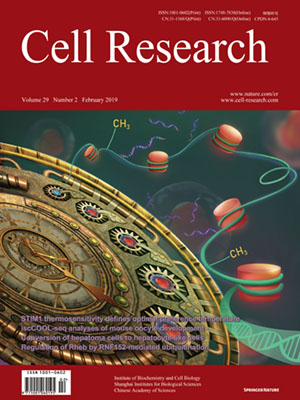
Volume 29, No 2, Feb 2019
ISSN: 1001-0602
EISSN: 1748-7838 2018
impact factor 17.848*
(Clarivate Analytics, 2019)
Volume 29 Issue 2, February 2019: 167-170 | Open Access
LETTERS TO THE EDITOR
Transcriptome-wide reprogramming of N6-methyladenosine modification by the mouse microbiome
Xiaoyun Wang 1, Yan Li 2, Wenjun Chen 3, Hailing Shi 4,5, A. Murat Eren 6, Aleksey Morozov 7, Chuan He 1,4,5, Guan-Zheng Luo 2 and Tao Pan 1
1 Department of Biochemistry and Molecular Biology, The University of Chicago, Chicago, IL 60637, USA; 2 State Key Laboratory of Biocontrol, School of Life Sciences, Sun Yat-sen University,Guangzhou, Guangdong 510275, China; 3 Department of Molecular Genetics and Cell Biology, The University of Chicago, Chicago, IL60637, USA; 4 Department of Chemistry, The University of Chicago, Chicago, IL 60637, USA; 5 Howard Hughes Medical Institute, The University of Chicago, Chicago, IL 60637, USA; 6 Department of Medicine, The University of Chicago, Chicago, IL 60637, USA and 7 Marine Biological Laboratory, Woods Hole, MA 02543, USA.
These authors contributed equally: Xiaoyun Wang, Yan Li.
Correspondence: Xiaoyun Wang (xwang13@uchicago.edu) orG-Z. Luo (luogzh5@mail.sysu.edu.cn) or Tao Pan (taopan@uchicago.edu)
Dear Editor,
Microbiome affects many aspects of human health and disease and elicits a wide range of host responses including remarkable epigenetic changes such as DNA methylation, histone modification and non-coding RNA expression.1 A still poorly explored area of microbiome-host interaction is the response of host RNA modification. N6-methyladenosine (m6A) is the most abundant mRNA modification in mammalian cells, occurring at ~3 modified adenosine residues per transcript. The m6A mapping and biology have been extensively studied recently.2 At the physiological level, m6A affects embryonic development, circadian clock, immuno-response, and others. At the cellular and molecular level, m6A affects all key aspects of mRNA processing, translation and decay. Importantly, m6A is a predominant, transcriptome-wide mark that is responsive to environmental changes; this dynamic m6A pattern is maintained by the writer enzyme complex containing the METTL3 a
https://doi.org/10.1038/s41422-018-0127-2
FULL TEXT | PDF
Browse 1176


